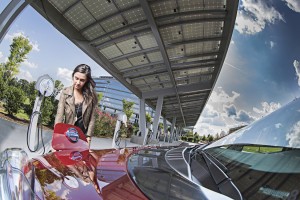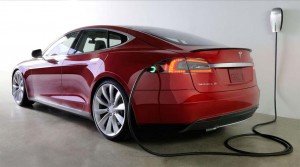
Despite the fact that Nissan Leaf buyers don't have to pay for gas as owners of an electric vehicle, EV sales are still less than 1% of new car sales.
Nearly half of all the battery-electric vehicles sold in the United States are going to customers in California, according to a new report by the U.S. Energy Information Administration, or EIA.
The report also noted that sales of plug-based vehicles, including plug-ins and pure battery-electric models, still constitute a tiny fraction of the total American vehicle fleet, with demand growing at a marginal pace despite a flood of new models.
Along with California, motorists in Hawaii and Washington have been quickest to plug into the electric vehicle market, with at least three of every 1,000 registered vehicles in those states. In only three states – Virginia, Georgia and Oregon – have EVs reached more than two in 1,000.
In California, there are now about five plug-based vehicles for every 1,000 registered cars, trucks and crossovers. Industry analysts credit several factors for that strong growth, including:
- Tax credits and other incentives including access to the state’s coveted high-occupancy vehicle lanes even with just one person in the vehicle;
- An environmentally conscious population;
- Strict new state-mandated Zero-Emissions Vehicle, or ZEV, rules.
The California Air Resources Board, or CARB, has set specific minimum targets for all major manufacturers. Miss that mandate and a maker could be barred from selling any of its vehicles in the state.
As a result, carmakers ranging from Ford to Toyota to BMW have been flooding California with new battery-car offerings. In some cases, vehicles are being sold solely in the Golden State, in other instances, they’re being launched in California then rolled out in other parts of the country – as happened with both the Nissan Leaf battery-electric vehicle and the Chevrolet Volt plug-in hybrid.
Eight other states have adopted California’s tough emissions standards, a move that should increase demand for electrics in places like Oregon and New York, industry planners believe.
But demand has accelerated at a far slower pace than was predicted by many experts – as well as the Obama Administration – just a few years ago.
“Total U.S. sales of plug-in electric vehicles have increased in recent years, but still represent only about 0.7% of new vehicle sales in 2014 so far, up from 0.6% in 2013 and 0.4% in 2012,” notes the EIA report.
The ongoing slump in fuel costs – which has seen pump prices slump to less than $3 a gallon, on average, across the U.S., is having a clear impact on demand for all alternative and high-mileage vehicles. According to a separate report by the University of Michigan Transportation Research Institute, the fuel economy of the average vehicle sold last month came to 25.3 mpg, down from 25.8 mpg in August.
(New car fuel ratings stagnate due to low gas prices. For more, Click Here.)
“Certainly, low fuel prices make it hard to sell (alternative power) vehicles like hybrids and electrics,” Ford global product development director Raj Nair told TheDetroitBureau.com last week.
Some automakers are looking for other ways to meet California’s ZEV mandate, meanwhile. Hyundai introduced a hydrogen-powered version of its Tucson SUV last summer, and a fuel-cell vehicle from Toyota, dubbed Mirai, will go on sale there in mid-2015. Honda will enter the hydrogen market in 2016.
(Click Here for details on Honda’s new hydrogen car, the Mirai.)
As with battery-cars, fuel-cell vehicles have challenges to overcome, primarily a limited number of places to fuel up, mostly limited to Southern California right now. But they can yield as much as 300 miles on a tank, a far less restrictive range than the 80 to 100 miles of most battery-electric vehicles per charge.
(To see more of the 2016 Toyota Tacoma debuting in Detroit, Click Here.)
A number of states are struggling to build momentum for battery cars, offering cash incentives – on top of the federal government’s maximum $7,500 in tax credits. Beyond California, nine other states, including California, Connecticut, Maine, Maryland, Massachusetts, New Jersey, New York, Oregon, Rhode Island and Vermont, account for a full 25% of total U.S. demand for plug-based vehicles.
All told, sales of plug-ins and pure battery-electric vehicles reached 106,834 for the first 11 months of this year, according to industry data, surpassing the 97,507 figure set in 2013.


Isn’t the Mirai a Toyota? (the link title)
How recent is this data? If it doesn’t include November, I’d suspect the picture is even worse for overall electric sales.
It’s no surprise considering the huge hit that batteries take in cold climates. Hybrids make sense but EVs are only practical for a minute percentage of the world.